MARIANI’S
Virtual
Gourmet
March 31,
2019
NEWSLETTER

❖❖❖
IN THIS ISSUE
EATING AROUND RICHMOND, VA
By John Mariani
THE JAMES BEARDS FOUNDATION
ANNOUNCES 2019 RESTAURANT NOMINEES
By John Mariani
NEW YORK CORNER
IBIZA KITCHEN
By John Mariani
NOTES FROM THE WINE CELLAR
CORVINA, CORVINA
By John A. Curtas
25
❖❖❖
EATING AROUND
RICHMOND, VA
By John Mariani
Like
many mid-size Southern cities, Richmond
(population 277,000) has in the past five years
been sprouting a wide range of restaurants in
every category and style, from the fine dining
at Lemaire in the Jefferson Hotel to Central
American restaurants like Saison and the
Mediterranean bistro Secco Wine Bar. Here are
some old, new, an in-between well worth a visit.
LEHJA
11800 West Broad Street
804-364-1111
I try
hard not to use superlatives often, and the
likelihood of any restaurant reaching that bar is
slim when it resides in a place like the Short
Pump Center, a shopping mall that could be
Anywhere, USA, full of all the usual stores like
Baby Gap, Banana Republic and Crate & Barrel,
along with eateries like Chipotle and Cheesecake
Factory. Lehja sits right across from the last,
but once inside you find yourself in a carefully
designed, very personalized restaurant owned by
Sonny Baweja (right), which The
Washingtonian magazine honors as among
Richmond’s top 15 restaurants.
But I’ll make the leap and say
that not only is Lehja one of the best restaurants
in Virginia, but one of the finest Indian
restaurants in America, not least for its
imaginative regional and modern cuisine but also
for its superb wine list (including a few Indian
bottlings) that Baweja has chosen to go with the
menu.
The three-room space and bar is
fresh, flush with color and sleekly modern, like
few traditional Indian restaurants anywhere look.
Many of the menu names of
dishes will sound familiar to aficionados of
Indian food, but here they have a spark and
identity unusual for their color, presentation and
impeccably cooked ingredients, from chaat papi made with
kale ($8), inspired by the food of India’s food
stalls, to curry scallops with beets, masala-dusted
leeks
and spiced coconut curry ($14). Heed the
descriptor of “firecracker chicken tikka”
($10), marinated in a pungent ghost chili with a
ribbon of pickled cucumber and a plate painted
with mango and kewra,
which tastes similar to rose water. It packs a
wallop.
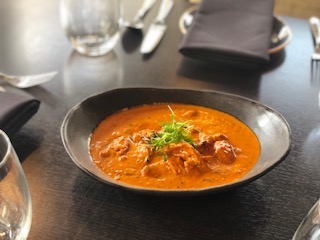 These
were followed by main courses of butter chicken in
bright, creamy yogurt (left) that tamed the fire of the
preceding chicken dish ($17), and chicken zafrani,
cooked in the tandoor after being marinated with
yogurt and saffron ($22). Duck à
la Pondicherry was like pulled pork, with spices
called vadouvan
that includes Tamil fenugreek mustard seeds,
cumin, curry leaves, garlic and onions,
accompanied by seared portobello mushrooms and
plantain crisps ($26).
These
were followed by main courses of butter chicken in
bright, creamy yogurt (left) that tamed the fire of the
preceding chicken dish ($17), and chicken zafrani,
cooked in the tandoor after being marinated with
yogurt and saffron ($22). Duck à
la Pondicherry was like pulled pork, with spices
called vadouvan
that includes Tamil fenugreek mustard seeds,
cumin, curry leaves, garlic and onions,
accompanied by seared portobello mushrooms and
plantain crisps ($26).
The spinach-based, cream
cheese-laced sag paneer
($16) had a marvelous complexity of textures and
flavors, and lamb vindaloo
($20) is a classic, here with more levels of
flavor than mere heat.
Several Indian breads (below) were
brought with the meal, including an unusual naan
topped with mushroom, local goat’s cheese and
truffle oil. Best plan is to order a basket with
assorted breads and chutneys ($8).
Freshly made, beautiful
desserts finished our meal: pistachio kulfi ice
cream ($7; below),
coffee & donuts with pastry cream and mocha
crema ($7), and strawberry-flavored ras malai
dumplings ($9). Here again, a sampler plate ($16)
is advisable for a table.
We left
ourselves in Baweja’s hands to choose the wines
he’s so proud of and the selections were very fine
accompaniments to the scads of flavors in Indian
food, from an Albert Bichot Crémant Rosé to a
remarkably good Bordeaux blend from Grover
Vineyards in the Nandi Hills of India.
All
the while Baweja will be there catering to your
table, suggesting you try this and that. If you
do, you’ll have a meal few other Indian
restaurants in America can match for creativity
and respect for true tradition.
Open daily for lunch and dinner.
The Roosevelt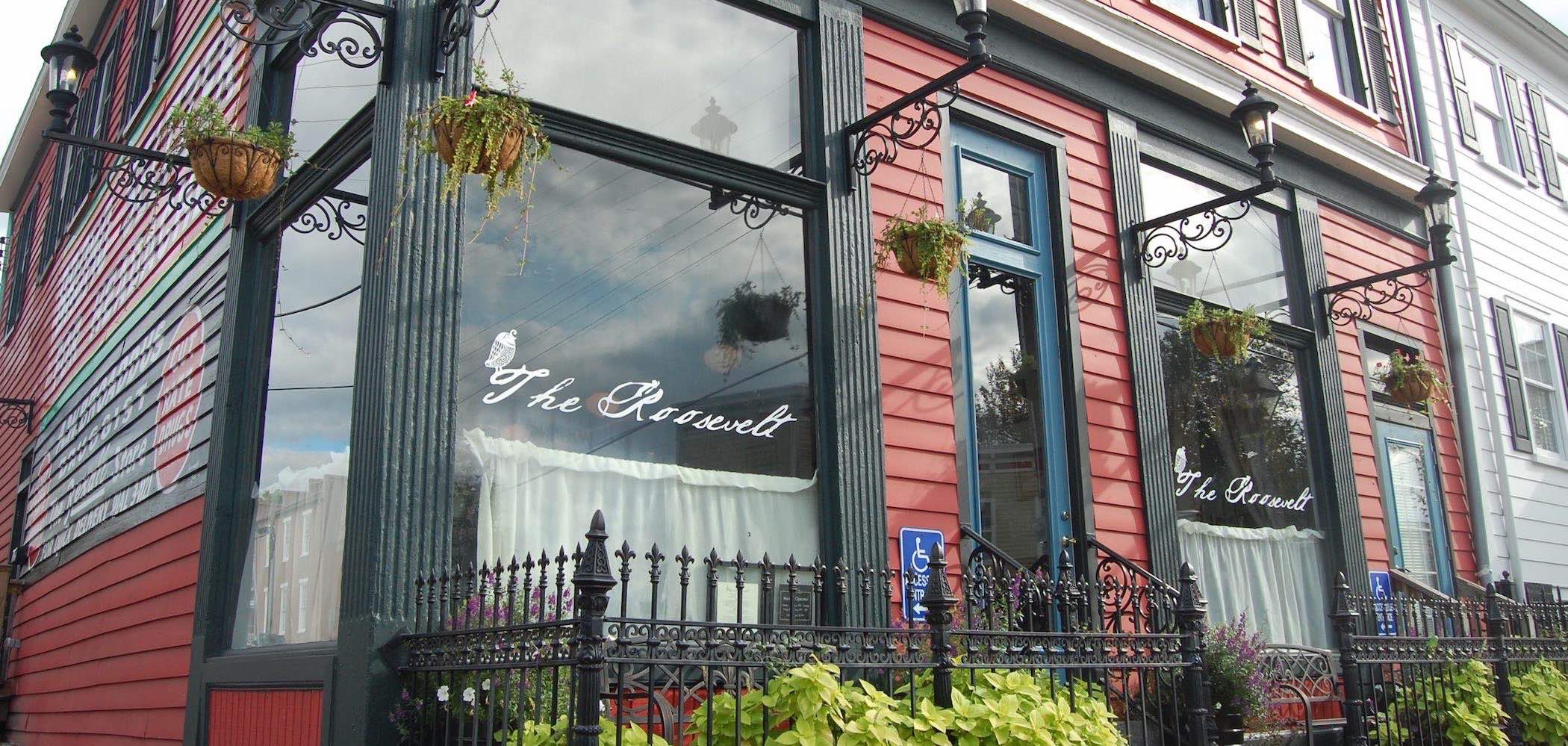
623 N. 25th Street
804-658-1935
Located in an old clapboard
building in Church Hill, The Roosevelt has been
around since 2011 and became an immediate local
success, winning several local awards, not just
for the homey look and the quality of its
sophisticated comfort food but for the care and
hospitality of chef Chef Matt Kirwan and partners
Kendra Feather and Mark W. Herndon, along with bar
manager Cary Carpenter.
The building dates to 1890,
first as a boarding house, then as a drug store,
and since 1950 one restaurant or another,
including a chitlin store. Although the menu
says something about being “a connection between
the land and our history and the food and wine
that have been defined by them,” I don’t quite see
the Roosevelt name connection.
It’s a charming big dining room
with an active bar, with a tin ceiling and walls
full of antiques gathered by Feather, sconces that
throw a soft light and ceiling fans. The
service staff is most accommodating, and you can
tell by the crowd that it’s a local spot that also
manages to draw a few tourists out to this neck of
the woods.
There is a snack section with
items like warm cornbread lavished with whipped
maple butter ($4) and hot
chicken wings with a BBQ rub ($9). I enjoyed
chicken liver toast ($8) with passionfruit jam,
pomegranate seeds, almonds and fennel powder,
though the jam seemed mixed into the whipped liver
and overly sweetened the dish.
There
are also small plates of vegetables, and a
wonderful parsnip soup laced with apple butter,
crunchy Virginian peanuts and a little nutmeg and
sage ($6). Main
courses run from seared rockfish with sweet
potatoes ($24) to a hanger steak with roasted
sunchokes, mushrooms, onions and horseradish
demi-glace ($26). It happened to be fried chicken
night, which I could hardly fail to order, and I
was ecstatic over the exceptionally crispy, dark
crust (right)
that stayed on juicy meat consistently cooked and
very hot throughout ($11). The kitchen drizzled on
some honey I would have preferred on the side.
For dessert
I very much enjoyed a homey bourbon-drenched
ginger cake ($6).
The Roosevelt prides itself on
its lengthy specialty cocktail list, and there
were 15 Virginia wine bottlings that night, with
about another 15 from other states, all at pretty
fair prices.
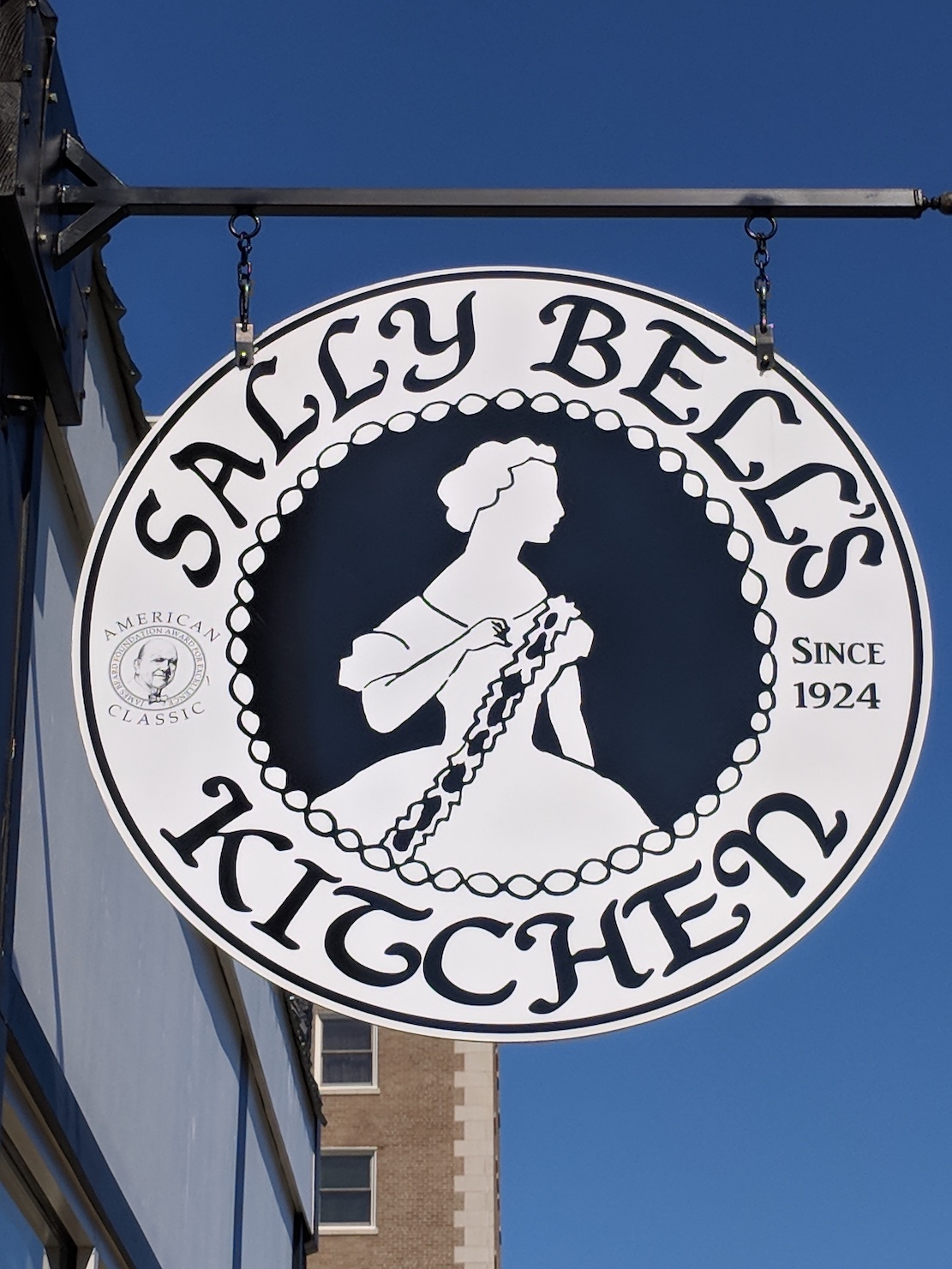 SALLY BELL’S KITCHEN
SALLY BELL’S KITCHEN
2337 West Broad Street
804-644-2838
Way back in 1977 my wife and
I were driving cross country and back on our
honeymoon, 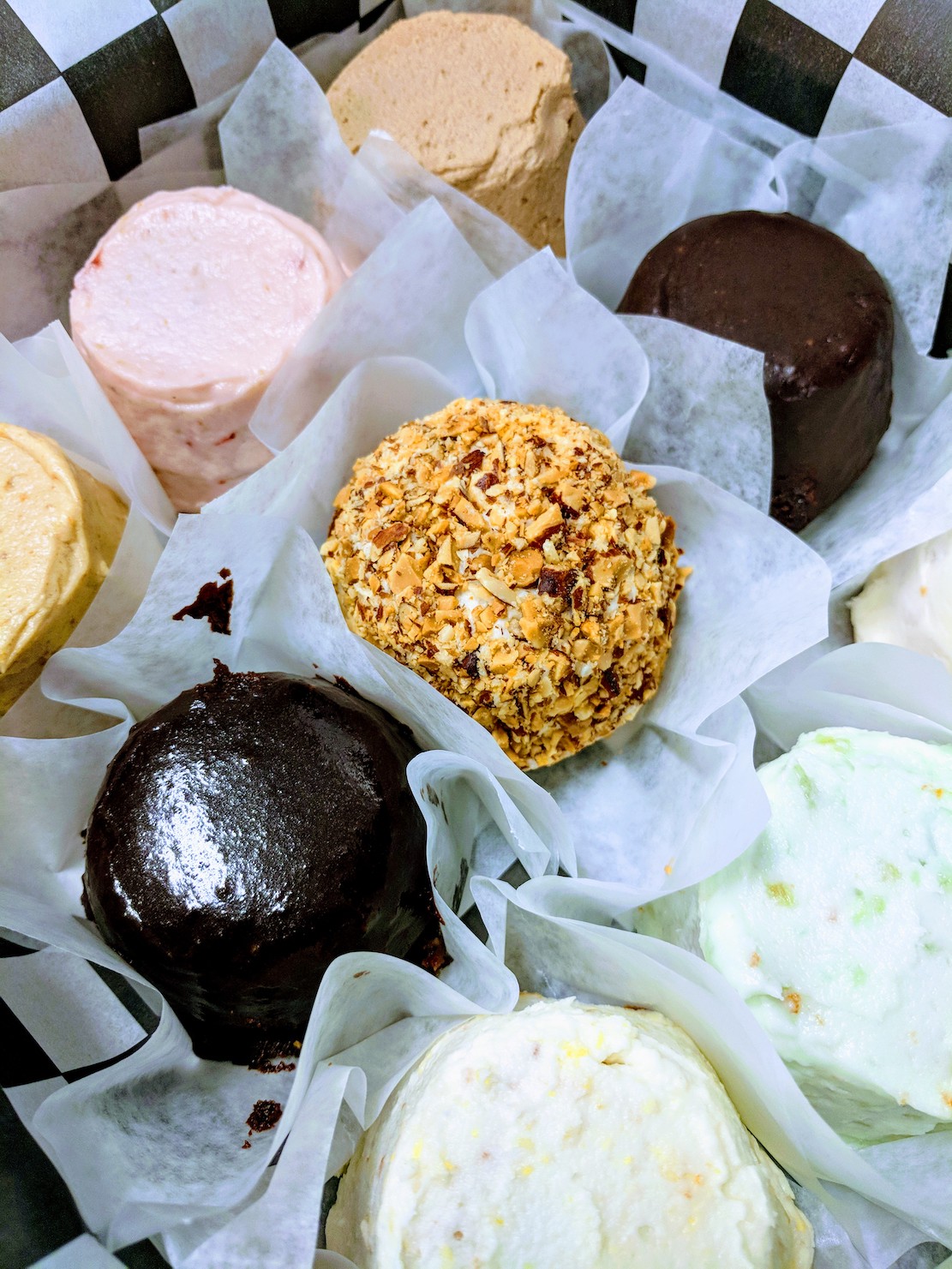 and very
little that we ate made us as happy as what we had
at Sally Bell’s Kitchen, then on Grace Street in
downtown Richmond. It was tiny, with a single
glassed-in counter showing the day’s goods, from
dainty sandwiches of Smithfield ham, egg salad,
pimento cheese, cream cheese and nut, and corned
beef spread, available in a box lunch with a side
of cole slaw or potato salad and dessert. The
desserts were myriad, from chocolate devil's food
and lemon yellow batter cupcakes to coconut pie,
lemon chess pie and sweet potato pie.
and very
little that we ate made us as happy as what we had
at Sally Bell’s Kitchen, then on Grace Street in
downtown Richmond. It was tiny, with a single
glassed-in counter showing the day’s goods, from
dainty sandwiches of Smithfield ham, egg salad,
pimento cheese, cream cheese and nut, and corned
beef spread, available in a box lunch with a side
of cole slaw or potato salad and dessert. The
desserts were myriad, from chocolate devil's food
and lemon yellow batter cupcakes to coconut pie,
lemon chess pie and sweet potato pie.
At a time when Cracker Barrel
was taking over the South’s food culture, Sally
Bell’s was a true rarity, opened in 1924 by Sara
“Sally” Cabell Jones, who called the shop Sarah
Lee Kitchen. But because of confusion with the
conglomerate baking company by that name, it was
changed in 1959 to Sally Bell’s. In 1963 Calom
Hunter Jones and his wife, Marcyne “Cene” Owdom
Jones, took over (she died last year) and passed
it on to daughter-in-law Martha in 2015, the year
Sally Bell’s was named 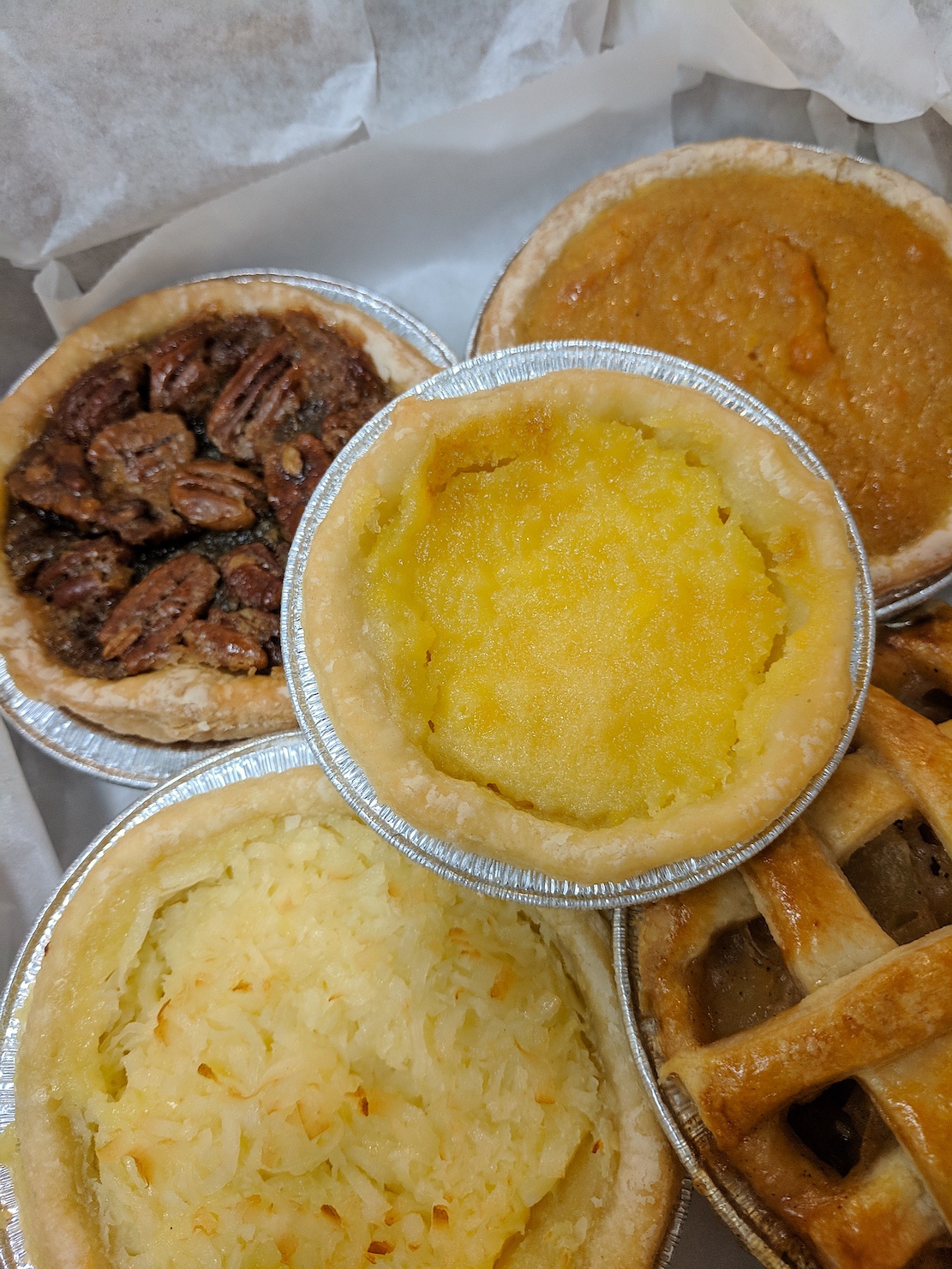 one of five
restaurants in the country to receive a James
Beard Foundation America’s Classics Award.
one of five
restaurants in the country to receive a James
Beard Foundation America’s Classics Award.
The eatery's original location
was bought by Virginia Commonwealth University,
and the eatery has now moved to West Broad Street
and much larger, spanking white quarters, just
across from the Science Museum. So for all kinds
of reasons I always try to get back to Sally
Bell’s Kitchen when I’m in town, and I still bring
home goodies for my wife.
It’s a very special place to so
many people, and to my wife and me it will always
be among our favorite moments of that
fourteen-week honeymoon, forty-one years ago.
❖❖❖
ANNOUNCES 2019 RESTAURANT NOMINEES
By John Mariani

The 2019 nominees
for the James Beard Foundation Awards for
restaurants have just been announced, and,
as the long, long list of more and more
categories grows, there is a good deal more
variety among the entrants.
The awards continue to be
called—with objections from the Academy of
Motion Picture Arts and Sciences—the “Oscars
of the Food World,” although the number and
qualifications of judges, largely drawn from
the food media, hasn’t the professional depth
of the Hollywood awards, for which
cinematographers vote for that technical award
and every voter must prove he’s actually seen
the movie.
 Having once chaired
the Restaurant Awards Committee for the
foundation for three years, I know that those
with the best publicists in the biggest cities
tend to win. I also know, however, that the
voting is on the up-and-up and, contrary to
widespread opinion, chefs and restaurateurs,
wineries and publishers cannot buy their way
into an award.
Having once chaired
the Restaurant Awards Committee for the
foundation for three years, I know that those
with the best publicists in the biggest cities
tend to win. I also know, however, that the
voting is on the up-and-up and, contrary to
widespread opinion, chefs and restaurateurs,
wineries and publishers cannot buy their way
into an award.
(The Beard Foundation also
gives awards to books, blogs, radio and TV
shows that I haven’t the space to consider
here.)
Overall—perhaps because
there are so many categories to compete in—the
list of nominees this year is highly inclusive
and very PC, with an admirable number given to
women and people of color. Given the headlines
about rapacious chefs these days, it’s
interesting to note the word “integrity” in
the description of the Outstanding
Restaurateur category.
The sudden
adulation for Los Angeles’s new-found
reputation as a bellwether gastro-city was all
too predictable. And the Best New Restaurant
category shows how the East and West Coasts
still dominate, with all five nominees located
in New York, San Francisco and Los Angeles.
By
the same token, in the overall Outstanding
Restaurant and Outstanding Restaurateur
categories, the nominees all have had
extensive coverage in the New York-based
media, with only one restaurant from the West
Coast—Quince in San Francisco. As with the
Oscars’ Best Picture and Best Director
categories, it’s difficult to figure why a
Best Restaurateur would not also run the Best
Restaurant. 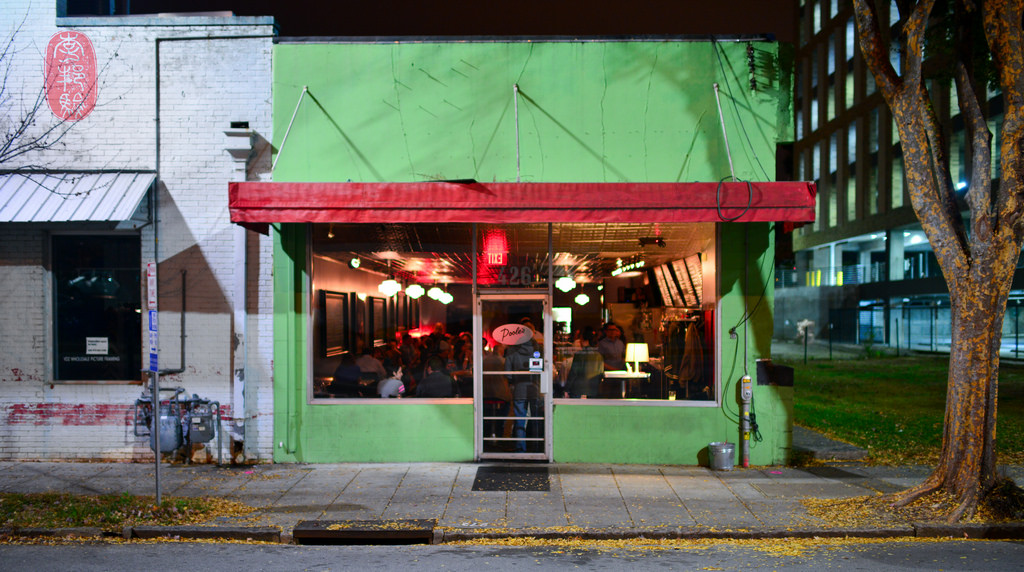
The Outstanding Chef
category dictates that the nominee “has served
as a positive example for other food
professionals,” suggesting he or she is well
known and much applauded nationally. On
the list are some true contenders in that
regard, like David Kinch of Manresa in Los
Gatos, CA,, and Corey Lee of Benu in San
Francisco. But does Ashley
Christensen of Poole’s Diner in Raleigh, NC,
really possess that kind of profile? (Frankly,
when I ate around Raleigh last year, no one
even mentioned Poole’s Diner as a place not to
be missed.)
Patrick O’Connell
(below),
chef/owner of The Inn at Little Washington in
Washington, VA, rightly received the Lifetime
Achievement Award for 2019.
 There
are some categories, like Outstanding Baker,
Bar Program, Pastry Chef, Service and Wine
Program, for which it is hard to discern what
makes any of the nominees stand out as unique,
especially since one wonders how many voters
actually visited those places and found them
heads above all others.
There
are some categories, like Outstanding Baker,
Bar Program, Pastry Chef, Service and Wine
Program, for which it is hard to discern what
makes any of the nominees stand out as unique,
especially since one wonders how many voters
actually visited those places and found them
heads above all others.
The Rising Star category—a
chef must be under 30 and “likely to make a
significant impact in years to come”—is tough
to prove, especially since all of them come
from major cities.
Then there are the Best
Chefs in all the regions of the U.S., from New
York to Hawaii. Largely these get their
support from the local media in their region,
which suggests the voting is probably the best
focused, although few of the voters travel
outside their immediate region. Yet in the
Great Lakes (Illinois, Indiana, Michigan and
Ohio), every nominee this year is in Chicago.
For some reason Minneapolis falls into the
Midwest category, taking three slots out of
six against one each for Kansas City and St.
Louis. With
one exception, all the Northeast nominees are
in Boston; in the Northwest, all are in
Oregon.
The South is broken into
two regions, with Puerto Rico slipped into
one, and what you might call Mid-South
(Georgia, Kentucky, North Carolina, South
Carolina, Tennessee and West Virginia) in
another. The Southwest covers a vast area,
including Texas and New Mexico, with four
Texas restaurants—three in Austin, but none in
Dallas or Houston—pitted against one loner in
Arizona.
California really means Los
Angeles and San Francisco. Hawaii is sadly in
this 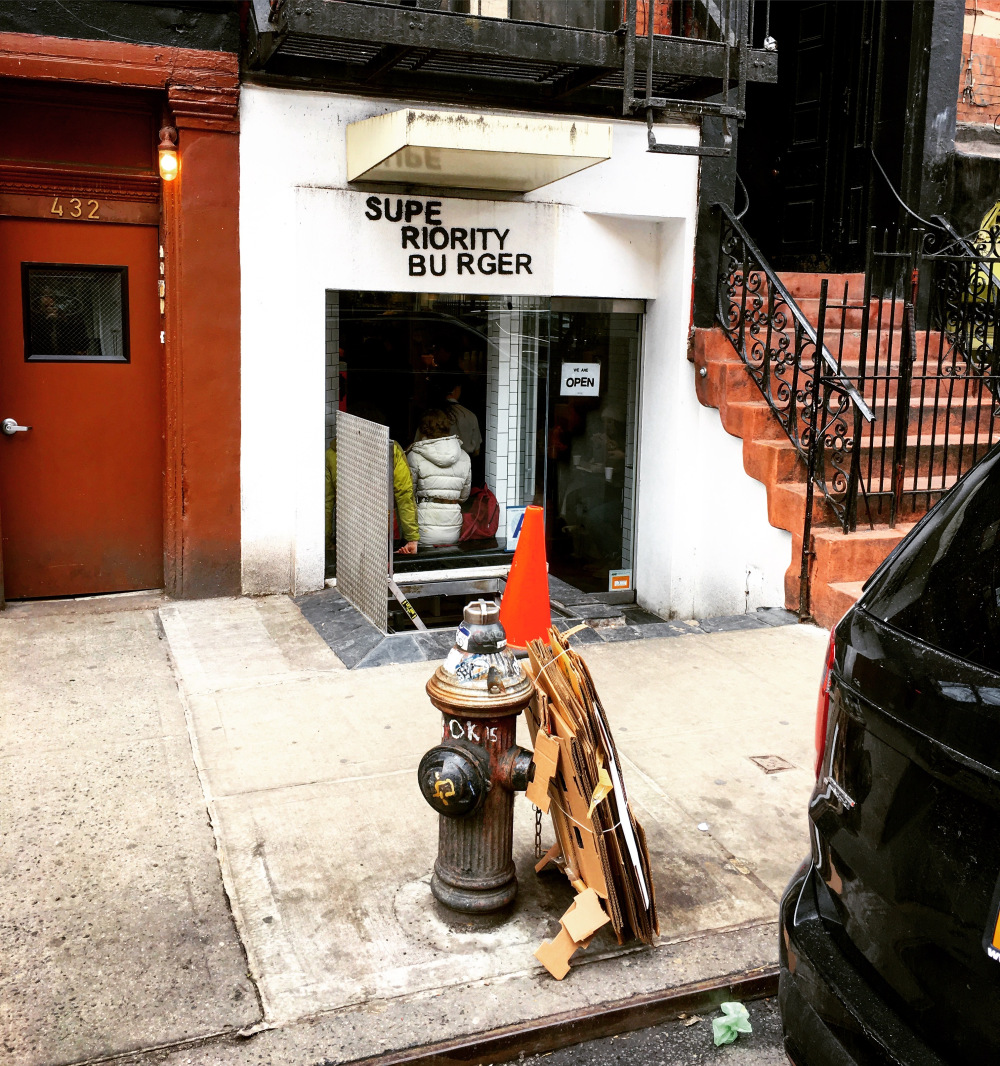 category with very
rare appearances on the list.
category with very
rare appearances on the list.
Then there is New York
City, which has in recent years been rife with
questionable nominees, like this year’s Brooks
Headley of Superiority Burger and Daniela
Soto-Innes of the small-plates Mexican spot
Atla. Any
new restaurant daring to pose as what used to
be called fine dining is banished from this
odd list.
Debate
over restaurant awards will always rage,
especially over the Michelin Guide’s
acceptance of cities’ million-dollar pay-offs
to cover it, the highly dubious Fifty Best
Restaurant Awards, which always gives top
prizes to the most expensive, eccentric,
impossible-to-get-into restaurants, and the
Zagat Surveys,which have gone through owners
and alterations that make it irrelevant.
There will always be some
head-scratching choices among the Beard
nominees this year, as always, and, as noted,
the winners will most likely be those that
have enjoyed the most media attention in the
past year.
As is typical of American awards in
general—that there are so many categories—it
must be depressing not to make one or more of
them at all.
By John Mariani
Photos by Laura Arias
78 King Street
Chappaqua, NY
914-458-5044
Lubina sea bass
Over the past
twenty years I’ve had several occasions to
pronounce Ignacio Blanco one of the finest
Spanish chef/restaurateurs in America, first
in TriBeCa
at Meigas (put out of business after 9/11),
again in a restaurante
named Ibiza in New Haven (now closed), then
in Ibiza in Danbury, Connecticut. Now that
he has added
a branch in Chappaqua, New York (about an
hour from midtown Manhattan, in Westchester
County), he and Chef Ivan Ortiz and Chef de
Cuisine Vanesa Oreiro seem emboldened by a
more affluent, well-traveled clientele not
seeking the usual dozen tapas selections you
find elsewhere. The menu even offers vegan,
gluten- and dairy-free items.
The range is extraordinary,
with some crossover from the Danbury Ibiza,
but there’s much that’s new. My table of four
people just told Ignacio to feed us and the
results were stunning.
We began with a mix of
greens, strawberries, pears, almonds, caña goat’s
cheese, aged Sherry and a raw honey
vinaigrette ($13) that set up the palate for
some piping hot “clam chowder” croquetas
($12), which were like Chinese soup
dumplings—you bite through a crunchy skin to
have the chowder ooze out to mix with a bacon
aïoli. Wild
Gulf shrimp ($17), fat and juicy, came with
shaved garlic, olive oil, lemon, parsley, guindilla
pepper and sea salt, with every element
playing a role in the taste and texture of the
dish. Marinated boquerones (anchovies)
glistened atop avocado, black olives, tapenade
and toast
(left).
The
first bay scallops of the season (below), vierias,
I’ve had were grilled with broccolini florets,
almonds and a rich cauliflower emulsion ($32),
and fresh creamy foie gras came with hazelnut
nougat, salt-cured tuna, mango and toast on
skewers ($15). Salmon was a special that night, napped with a maple bourbon
glaze from the local Taconic
Distillery ($32), while lubina ($32) was a salt-baked sea bass with root
vegetables confit, pinenuts, raisins and paprika oil.
Pato Asado ($29) was juicy breast of duck breast with crusty grilled
polenta, smoked bacon, dates and a
tart citrus sauce. Slowly cooked baby back
ribs called costelitos
($26) had a pungent mustard-laced potato puree with
sweet notes from Asian pears and soothing
aïoli.
First-rate desserts followed: a traditional torrija
moderna was a caramelized bread pudding
($11) a Basque “drunken cake” called
goxua
with English cream, caramelized crema
pastelera and blood orange foam ($11),
and plump chocolate croquetas
(right)
with crushed almonds, coconut foam and lime
gelatin ($12).
The wines selected, from
the Spanish Artisan Wine & Spirits Group,
went impeccably with the food: Albariño Lagar de Candes; Valdeorras Godello
from Adegas D. Berna; and Ribeira Sacra
Mencía red from Val da Lenda.
Ibiza’s décor, which is now
fairly stark, is a work in progress, but the
lighting is good and shows off the food very
well. The sound level is also civilized.
Anyone
who goes to San Sebastián in Spain will find
scores of tapas bars serving varying versions
of the same dozen dishes, but at Ibiza in
Chappaqua the genre has been greatly expanded
by Ignacio Blanco with respect, imagination
and vision.
Ibiza is open for dinner Tues.-Sun
The Wines of the Veneto
By John A. Curtas
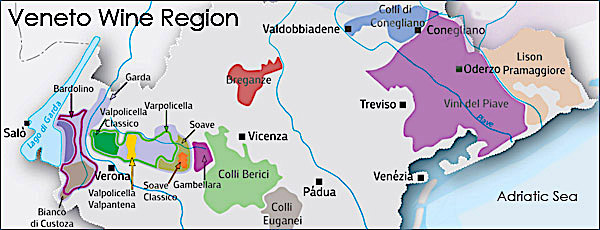
If
there's a wine region of Italy that can be
said to be unsung, it is probably the
Veneto.
Stretching from
Lake Garda in northwestern Italy, to the
shores of the Adriatic sea, this area
has long been famous for producing oceans of
supermarket Soave and light, gulp-able
versions of its slightly weightier red
cousins, Bardolino and Valpolicella. Both of
the latter are made primarily 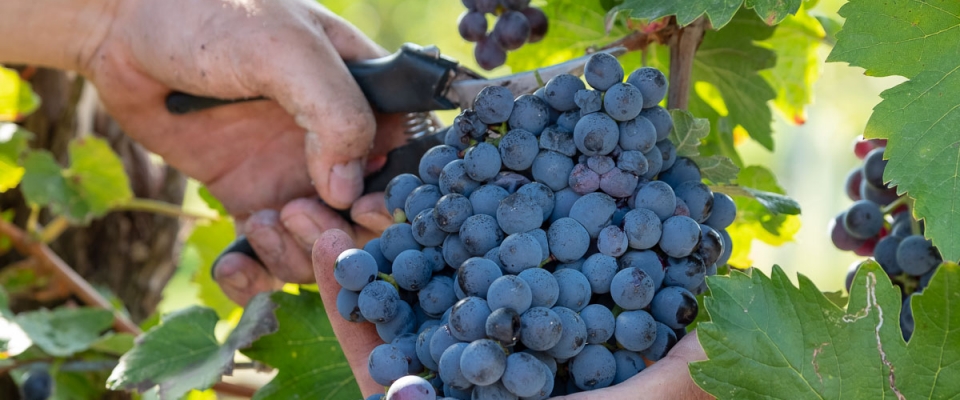 from the Corvina
grape (left),
with various amounts of Rondinella and
Molinara tossed in for fragrance or body. But
aside from the region’s most venerated wine:
the muscular Amarone (itself something of a
late 20th Century phenomenon), these wines
have never garnered the respect doled out to
varietals in Tuscany or the Piemonte. In many
ways, they were victims of the region's
success with its lighter wines -- so much
mass-produced Soave and red Valpolicella was
sold in the 1970s and 1980s, they became
generic brands unto themselves, and the better
versions of these wines got lost in the flood.
from the Corvina
grape (left),
with various amounts of Rondinella and
Molinara tossed in for fragrance or body. But
aside from the region’s most venerated wine:
the muscular Amarone (itself something of a
late 20th Century phenomenon), these wines
have never garnered the respect doled out to
varietals in Tuscany or the Piemonte. In many
ways, they were victims of the region's
success with its lighter wines -- so much
mass-produced Soave and red Valpolicella was
sold in the 1970s and 1980s, they became
generic brands unto themselves, and the better
versions of these wines got lost in the flood.
Which is a shame, since a
tour of the region recently showed us how much
variety there is in a place long overdue to
take a bow for what it produces for the world
to drink. This trip was not about the
much-maligned Soave (or the ever popular Pinot
Grigio, also made in the Veneto), but rather,
it was concerned with Corvina -- the grape
that is the backbone of all the region's reds
and blush wines. Our travels took us from the
town of Bardolino, along the coast of Lake
Garda, and then to wineries in both the
Bardolino and Valpolicella -- wine countries,
where the DOC (Denominazione di Origine
Controllata) designation has been granted (not
without controversy) to wines ranging from the
palest pink to the thickest, most
mouth-coating red.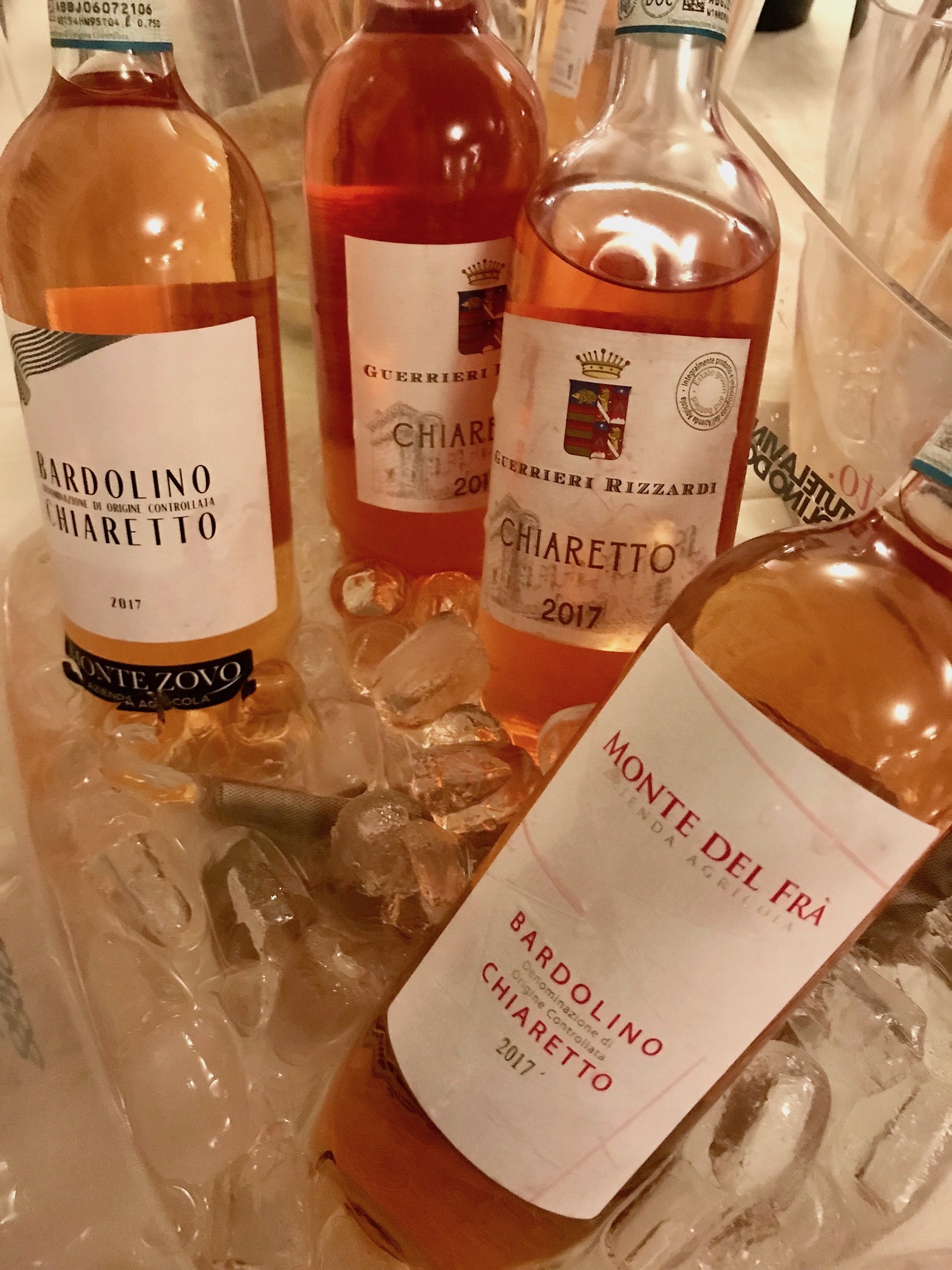
The Key to Chiaretto - a whiter shade of pale
The
smokey, thick-skinned Corvina grape makes
everything from those unctuous Amarone to
light and refreshing Chiaretto
(key-ar-et-toh). In between there are the
crisp, cherry-bright Bardolinos, and
Valpolicella—wines ranging in intensity from a
simple pizza parlor drink to "ripasso" wines
of startling complexity.
To decipher how so many
styles can be made from so obscure a grape, we
buckled into a wine tour that traversed the
commune of Bardolino, and then plunged deep
into the heart of the Veneto. In between we
visited what may be the oldest wine tasting
bottega in the world, before ending our trip
at a modern Italian restaurant that took our
breath away. But first, we started as so many
meals do in the Veneto, with a glass of
Chiaretto, to put us, as it were, in the pink.
We began on the shores of
Lake Garda, with a traditional meal at Ristorante
Menapace (below) in the picture
postcard town of Torri Del Benaco. There, chef
Luca Monese treated us to a dinner of lake
fish specialties, Lavaret "saor" (whitefish
escabeche,) marinated in a sweet-sour sauce, zuppa de pesci
del Garda (fish soup), and spaghetti
with breadcrumbs), all meant to highlight the
flavors of the local Chiaretto laid before us.
As introductions to wines go, it was a bit
daunting -- at least two dozen rosato
(rosé) wines were tasted -- but we powered
through with the help of both the wine makers
themselves, and experts like Elizabeth Gabay
MW, whose recently published book Rosé -
Understanding the Pink Wine Revolution helps to explain the "rosé
all day" trend that has revived interest in
pale wines for a younger generation of
drinkers.
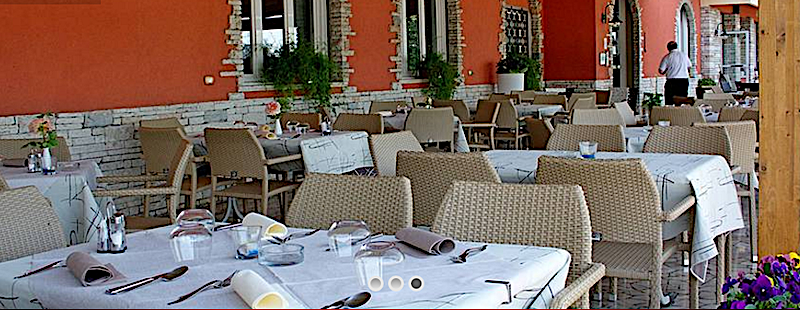 Chiaretto
di
Bardolino (or simply Chiaretto), as it is
locally known, is a (generally) paler rosé
produced on the shores of Lake Garda. Chiaro
means "light or pale" in Italian, and it was
one of the first appellations in Italy to be
awarded the DOC denomination (in 1968) in
recognition of the wine's historic tradition.
For the longest time, it was thought of as a
simple quaffing wine, but a new generation of
Italian winemakers -- who have taken note of
the rosé revolution going on around the world
-- are trying to upgrade its image by creating
wines with more aromatic and floral notes.
Freshness and citrus fruits are what comes
through with Chiaretto, along with a whiffs of
minerality, salinity, and herbaceousness. It
may not have the depth of the storied rosés of
Bandol and Tavel, but what it lacks in their
complexity, it makes up for in bright
drinkability, not to mention extreme
food-friendliness. It's hard to imagine a
better summertime wine, and at price usually
well under $20/bottle, it is hard to imagine a
better bargain as well.
Chiaretto
di
Bardolino (or simply Chiaretto), as it is
locally known, is a (generally) paler rosé
produced on the shores of Lake Garda. Chiaro
means "light or pale" in Italian, and it was
one of the first appellations in Italy to be
awarded the DOC denomination (in 1968) in
recognition of the wine's historic tradition.
For the longest time, it was thought of as a
simple quaffing wine, but a new generation of
Italian winemakers -- who have taken note of
the rosé revolution going on around the world
-- are trying to upgrade its image by creating
wines with more aromatic and floral notes.
Freshness and citrus fruits are what comes
through with Chiaretto, along with a whiffs of
minerality, salinity, and herbaceousness. It
may not have the depth of the storied rosés of
Bandol and Tavel, but what it lacks in their
complexity, it makes up for in bright
drinkability, not to mention extreme
food-friendliness. It's hard to imagine a
better summertime wine, and at price usually
well under $20/bottle, it is hard to imagine a
better bargain as well.
Here are some notable
Chiaretto you should be sipping poolside this
summer. Some are available in the United
States, while others are looking for
distribution here. Either way, these tasting
notes will give you an idea what to expect at
some very friendly price points: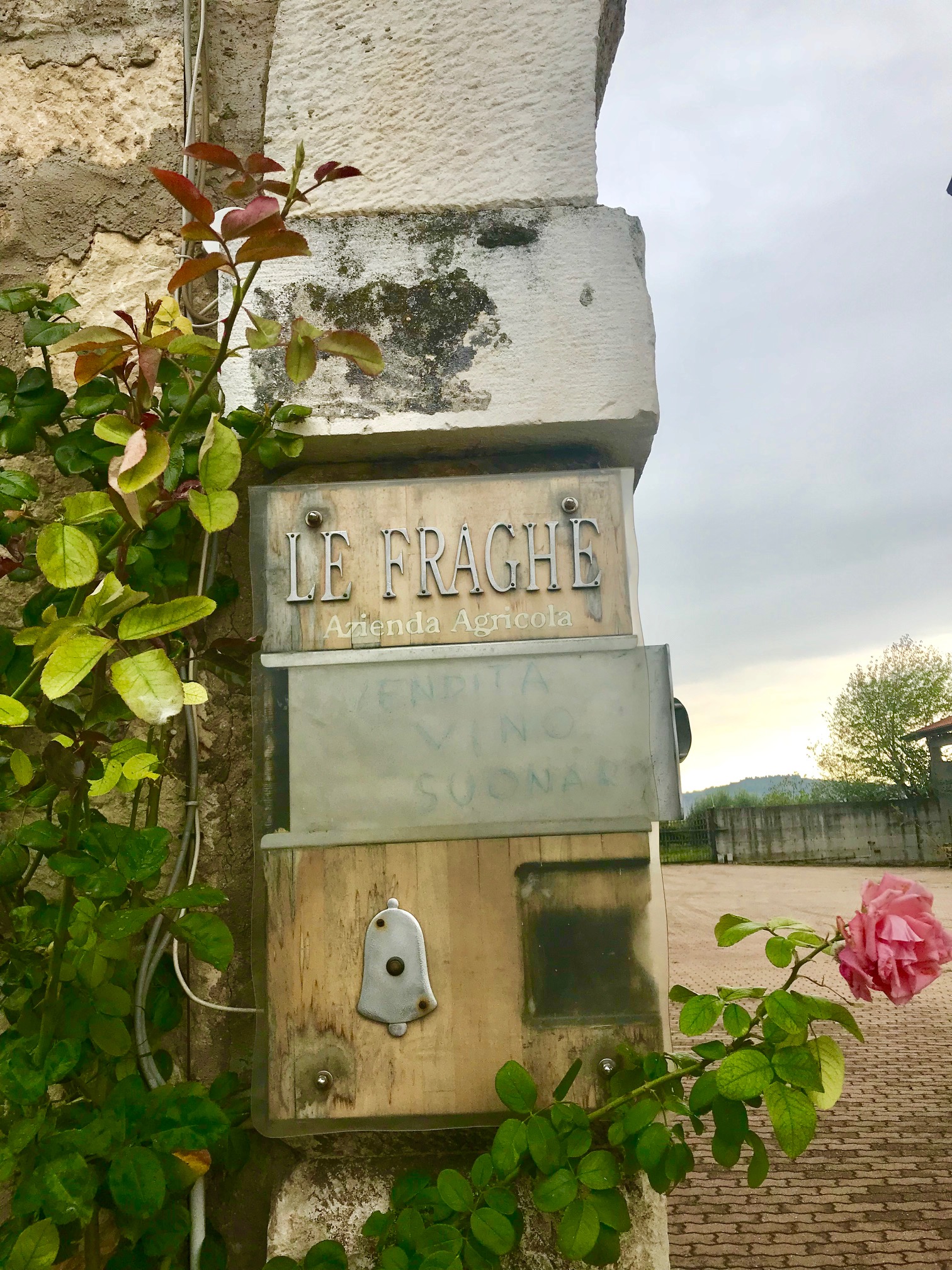
Santi Infinito Rosé 2017
Bright
aromatic notes of ripe strawberries and
cherries. Very pale pink caused by short
contact with the grape skins, but lively and
fresh on the palate, making it a perfect match
with seafood and salads. $12 retail.
Le Fraghe 2017 Rodon
Bardolino Chiaretto
A tasty, almost salty
minerality comes through at first, followed by
fragrant red berry aromas and a hint of spice.
Ideal with salmon, it shows lots of crispness,
finesse and energy, and a hint of bitter
herbs, rather than fruit forward, but still
quite a mouthful for $16.
Albino Piona 2017 Bardolino
Chiaretto
Pale, dry, and light on the
palate with a strong mineral nose, this is a
classic quaffing Chiaretto of the sort you see
accompanying pizzas in trattorias all around
Lake Garda. $15 retail.
Poggio delle Grazie 2017
Bardolino Chiaretto DOC
Another classic Chiaretto
(80% Corvina and 20% Molinara blend), this one
retails for around $10 if you can find it.
Bracing, but rounder and softer in the mouth
than many of its rivals, with a hint of salt
on the front palate - a perfect aperitif to
sip with antipasti. Around $15.
Monte Zovo 2017 Bardolino
Chiaretto
Very indicative of the style
they shoot for in these Italian blush wines:
crisp, pale, austere and very dry, it presents
whiffs of white flowers and is not for those
who demanding a lot of sappy, feminine
fruitiness in their glass. Around $10.
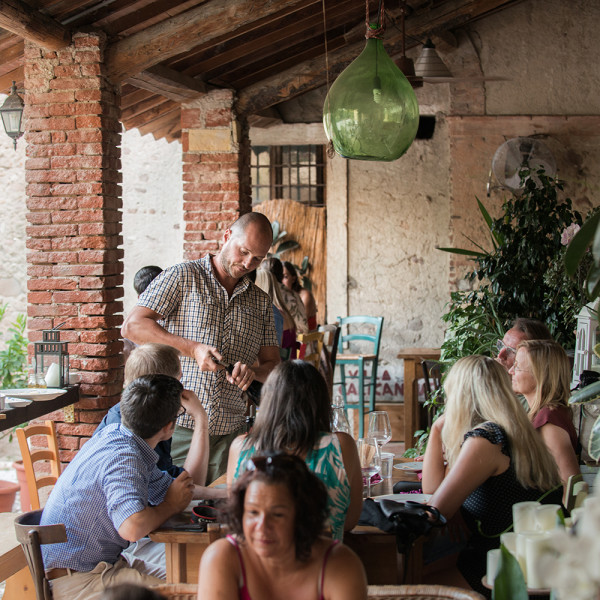
Villa Calicantus Chiar' Otto Vino Rosato
2017
Winemaker Daneile Delaini at
Calicantus (left)
uses organic, biodynamic methods to produce an
array of wines from his hand-picked 6 hectares
in the hills above Bardolino (left). He
ages his reserve Chiaretto in wood vats which
allows it to develop a complexity his
competitors can only dream about. A
mineral-rich nose leads to bright red fruits,
with a mildly tart finish. Sleek,
elegant, and balanced, with beautiful length.
An amazing wine for under $20/bottle. It's too
bad you can't buy it in the United States.
Yet.
Guerrieri Rizzardi
Chiaretto DOP Classico 2017
G R is a large
operation -- the polar opposite of Villa
Calicantus, Monte Zovo, and many of these
family-owned wineries. It dates back to the
16th Century and is the product of two ancient
Veronese wine producers coming to
together in 1914 to produce their first joint
vintage. Production is over 750,000
bottles of wine a year, ranging from Chiaretto
spumante to Amarone della Valpolicella DOCG.
(The Calcarole 2011 Amarone, its most recent
release, is a knockout worth searching for.)
The winery and tasting rooms are within
walking distance of downtown Bardolino, making
a visit here mandatory on any wine tour of the
region. Its Chiaretto is emblematic of the
style: spicy, herbal, restrained nose,
finishing dry but not astringent. Like all of
these Chiaretto, it is eminently drinkable and
matches well with almost any seafood pasta you
can think of -- which is quite a bargain for
ten bucks a bottle.
Tinazzi Ca' de' Rocchi
Bardolino Chiaretto DOP Campo delle Rosé
2017
Giorgio
Tinazzi, shown at the right with his father
Giorgio and sister Francesca own the smallest
estate in the area and produce wines
through biodynamic growth.The name means "Field of
Roses." Pearly-pink and deeper colored than
most Chiaretto, its visuals indicated it
would be a bigger, richer rosato than most,
and the color didn't lie. A wine full of
cherry and raspberry aromas, with a longer
finish than many of its rivals. Along with
Calicantus, definitely the Chiaretto of the
trip. It retails for around $20/bottle, and
its salmon-colored cousin—I Serengni
(named for the round stones in the
vineyard)—was even more opulent for around $10
more.
Giorgio Tinazzi, shown at the right with his
father Giorgio and sister Francesca own the
smallest estate in the area and produce
wines through biodynamic growth.
I
have to admit that when I began this
expedition, I had no idea what to expect from
these wines. Italian rosé may not be the first
wines to spring to mind when you think of
drinking pink, but they may be the best
bargain in blush wines available on the market
right now. They are clean and refreshing
drink, nothing to really ponder, but a lot of
satisfaction in the glass, and something I’d
much rather sip than some insipid Soave.
Next Week:
The other wines of the Veneto.
❖❖❖
 OH, JUST SPIT
RIGHT BACK AT THEM
OH, JUST SPIT
RIGHT BACK AT THEM
"By going to the source of the modern farm-to-table movement, I wanted to see a perfected vision of the culinary ideals that have permeated American dining culture in the years since Chez Panisse’s opening in 1971. You want a revelation—not that cheap ghost of an idea that lazy food writers use to say that something was especially delicious, but an experience that truly upends and spits upon what you, ignorant soul, assumed about how the world worked.”--Soleil Ho, "The Fantasy — and Reality — of Dining at Chez Panisse," San Francisco Chronicle (2/28/19).
ANYONE WHO WAITS FOUR HOURS FOR A BURGER
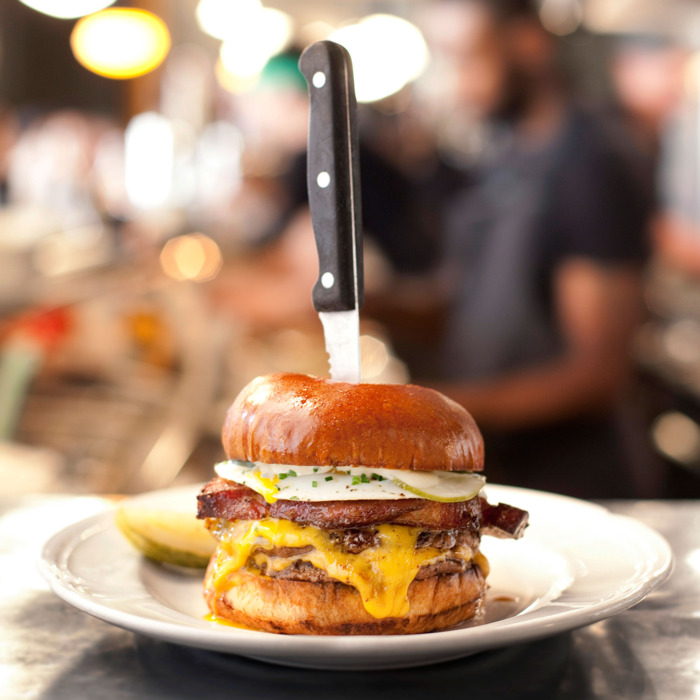
AND AN EGG ISN'T LIVING HIS LIFE RIGHT
Eater.com reports that at the branch of Au Cheval in NYC, which features a burger with an egg on top with a knife in it, "If you want to be seated immediately, you’re well advised to go precisely at 11 a.m. on a weekday, as I did on my second visit. Last weekend during the day, the line was reportedly more than 70 people deep, and quoted waits went up to four hours."
Wine
Column Sponsored by Banfi Vintners
SANGIOVESE
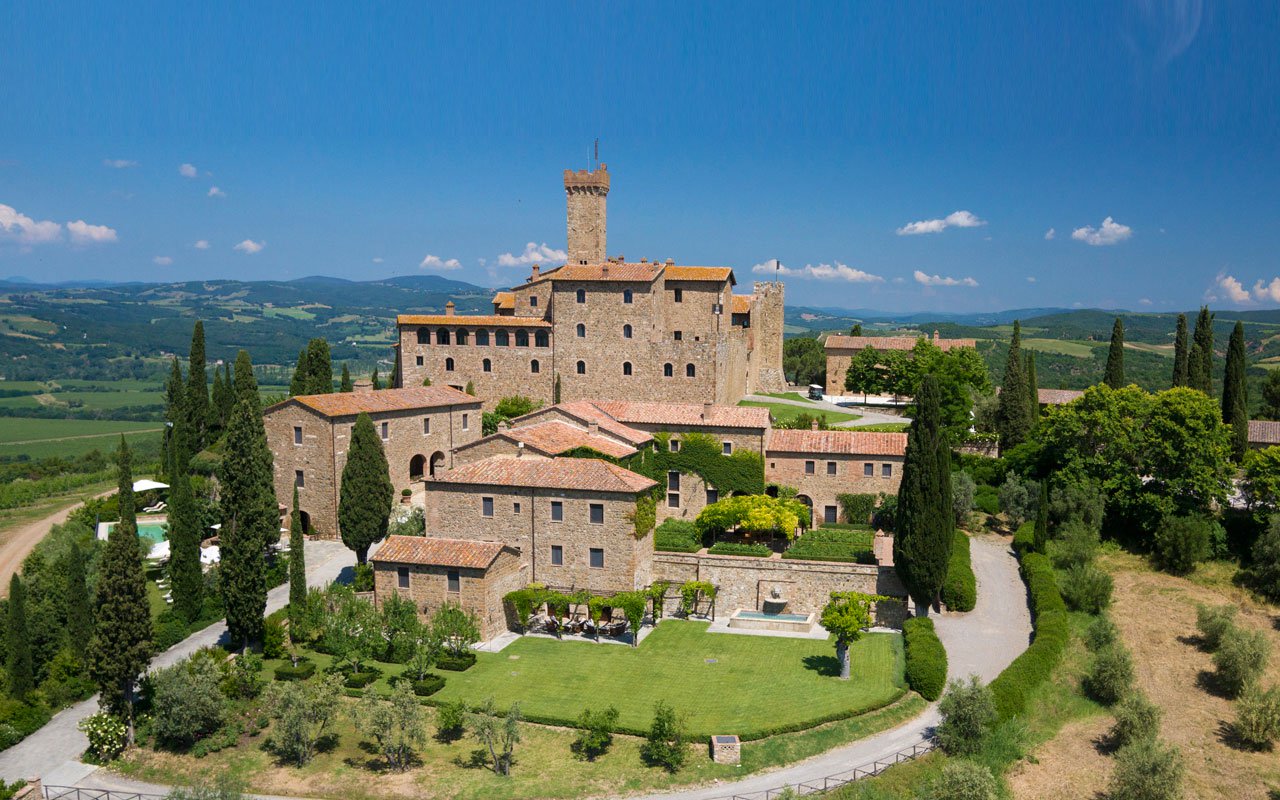 Wine is a joy year-round but
in cooler weather one
grape varietal has really taken center stage in
my daily activities – that most Italian of
grapes, Sangiovese, and its ultimate expression
– Brunello di Montalcino.
Wine is a joy year-round but
in cooler weather one
grape varietal has really taken center stage in
my daily activities – that most Italian of
grapes, Sangiovese, and its ultimate expression
– Brunello di Montalcino.
From mid-September through mid-October,
the Sangiovese grown for our various styles of red
wines are be harvested, culminating with the top
selection for Brunello di Montalcino.
Second, cooler weather here means
it is time to start enjoying more red wines and
especially Sangiovese based wines. That
includes Banfi’s cru of Brunello, Poggio alle Mura,
literally the cream of the crop of our Sangiovese
vineyards. Alongside our Poggio alle Mura Brunello di
Montalcino, this year we introduced two more wines
from the cru Poggio alle Mura – a Rosso di Montalcino
and a Riserva of Brunello. Rosso is sort of like the
younger brother of Brunello, also made from 100%
Sangiovese grapes but usually a selection from younger
vines and the wine is aged only two years compared to
the four required for Brunello. The
Riserva, on the other hand, is an even more selective
harvest of Sangiovese, and ages for an additional year
before release.
What is so special about this cru
Poggio alle Mura?
Well, it is the result our over 30 years of
ongoing research at my family’s vineyard estate,
Castello Banfi.
When we first began planting our vines there in
the late 1970s studies from the University of Bordeaux
indicated which strains of many varietals we should
plant, based on the soil type and microclimate of each
vineyard. But
when it came to the region’s native Sangiovese, there
was only local lore, no scientific research. So we took
it upon ourselves to figure out this vine, and set off
on three decades of incredibly detailed research.
We started
with 600 apparent variations on Sangiovese, because it
is so susceptible to variations in weather and soil,
and narrowed that down to 160 truly genetically
different clones.
We planted a vineyard with two rows of each
type, made wine from each of them, and charted the
differences – remember, you only get one chance a year
to make wine, so this took time.
It took about ten years to get some
concrete results, though we continue to experiment
today and always will – you never stop learning in
science and nature!
Once we determined which were the best,
complementary clones that could be planted together to
make the best Brunello, we chose to plant them in what
we determined to be the optimal vineyard sites. Coincidentally,
the best soils and climate conditions are in the
slopes surrounding the medieval fortress today known
as Castello Banfi, known since Etruscan times as
Poggio alle Mura – the walled hilltop. Hence the
name of our most special “cru” of Brunello,
representing a synthesis between tradition and
innovation.
Though the focus of this study was
our Brunello, all of our Sangiovese-based wines,
including the super Tuscans SummuS, Cum Laude, and
Centine, benefitted from this work. And that’s
the third reason for celebrating Sangiovese this
month, for the range of wonderful reds that usher us
into autumn! One
wine in particular was inspired by our research – the
BelnerO, a Sangiovese dominant blend with what I like
to call a kiss of Cabernet and a whisper of Merlot. We grow the
grapes a little differently for BelnerO than for
Brunello, make the wine with less oak aging and
released it earlier from the winery, providing a
counterpoint to Brunello and a lovely terroir-driven
wine in its own right.
If you
know Italians, you know that by nature we are
multi-faceted, varying in mood, and always passionate. As a
nation, we span from the hot sunny beaches of Sicily
near the African coast to the rugged mountains and
Alpine ski slopes of Trentino-Alto Adige in the north. Sangiovese
is grown in almost all of Italy’s regions and reflects
the unique nature of each; it is most famous
(rightfully so) in Tuscany, yet even there it reflects
the nuances of each hilltop, valley and subzone. It has
something a little different to say in Brunello than
Chianti, Morellino than Vino Nobile di Montepulciano,
Rosso di Montalcino than Super Tuscan blends.
Here is a smattering of
Sangiovese-based wines that you may wish to get to
know better, reflecting a spectrum that appeals to
every occasion, every taste, and every budget. We can
assure you that the conversation will never become
boring. 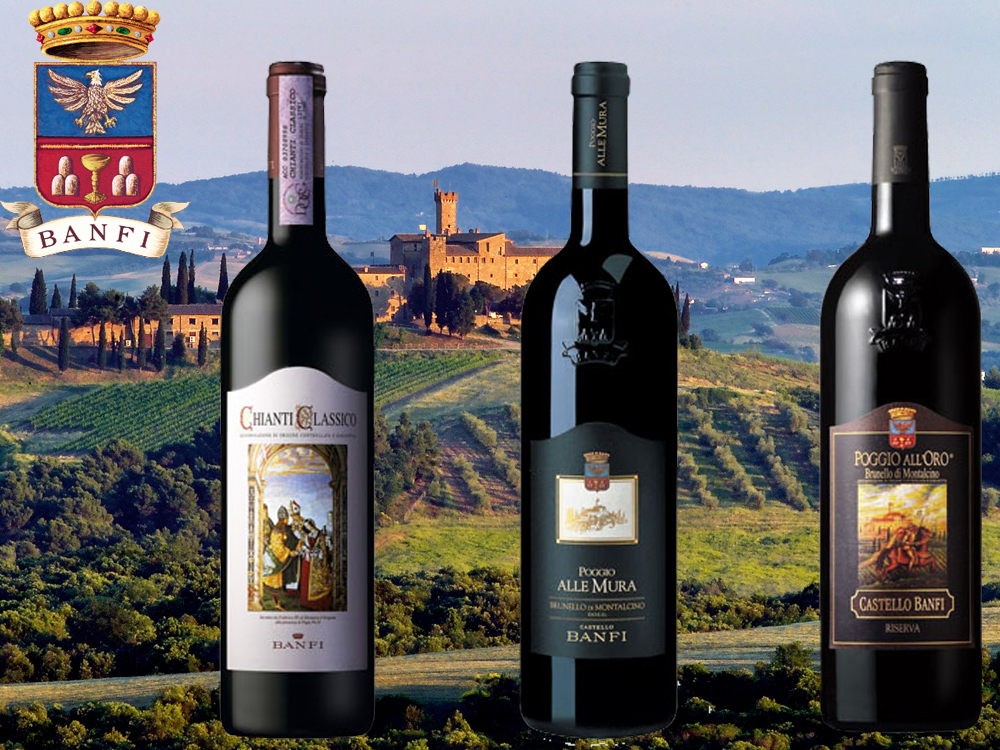
Recommendations for Celebrating
Sangiovese
BelnerO Proprietor’s Reserve Sangiovese
– A refined
cuvée of noble red grapes perfected by our pioneering
clonal research. This dark beauty, BelnerO, is
produced at our innovative winery, chosen 11
consecutive years as Italy’s Premier Vineyard Estate.
Fermented in our patented temperature controlled
French oak and aged approximately 2 additional years.
Unfiltered, and Nitrogen bottled to minimize sulfites.
Castello Banfi Brunello di Montalcino –
Rich, round, velvety and intensely
aromatic, with flavor hints of licorice, cherry, and
spices. Brunello di Montalcino possesses an intense
ruby-red color, and a depth, complexity and opulence
that is softened by an elegant, lingering aftertaste.
Unfiltered after 1998 vintage.
Castello Banfi Rosso di Montalcino – Brunello's "younger brother," produced
from select Sangiovese grapes and aged in barrique for
10 to 12 months. Deep ruby-red, elegant, vibrant,
well-balanced and stylish with a dry velvety
finish.
Poggio all’Oro Brunello di Montalcino
Riserva – A single vineyard selection of our most
historically outstanding Sangiovese, aged five years
before release, the additional year more than that
required of Brunello including 6 months in barrel and
6 months more in bottle to grant its “Riserva”
designation. Incredible
elegance and harmony. Intense with lots of fruit and
subtle wood influence. Round, complete, well balanced
with hints of chocolate and berries. Unfiltered after
1998.
Poggio alle Mura – The first tangible result of years of
intensive clonal research on Montalcino’s native
Sangiovese grape.
Estate bottled from the splendidly sun drenched
vineyards surrounding the medieval Castello from which
it takes its name.
The Brunello
di Montalcino is seductive, silky and smoky. Deep ruby
in color with an expressive bouquet of violets, fruits
and berries as well as cigar box, cedar and exotic
spices. The Rosso
di Montalcino is also intense ruby red. The bouquet
is fresh and fruity with typical varietal notes of
cherry and blackberry, enriched by more complex hints
of licorice, tobacco and hazelnut. It is full
bodied, yet with a soft structure, and a surprisingly
long finish. The Poggio alle Mura Brunello di Montalcino
Riserva is deep ruby red with garnet
reflections and a rich, ample bouquet that hints of
prune jam, coffee, cacao and a light balsamic note. It is full
and powerful, with ripe and gentle tannins that make
it velvety and harmonious; this wine is supported by a
pleasing minerality that to me speaks soundly of that
special hillside in southern Montalcino.
SummuS – A wine of towering elegance, SummuS is an
extraordinary blend of Sangiovese which contributes
body; Cabernet Sauvignon for fruit and structure; and
Syrah for elegance, character and a fruity bouquet. An elegant,
complex and harmonious red wine.
Cum Laude – A complex and elegant red which graduated
“With Honors,” characterized by aromas of juicy
berries and fresh spices.
Centine – A Cuvee that is more than half
Sangiovese, the balanced consisting of equal parts of
Cabernet Sauvignon and Merlot. Vinified in
a firm, round style that easily accompanies a wide
range of dishes, this is a smooth and fragrantly
satisfying wine with international character, and a
perennial favorite at my own dinner table.
Banfi Chianti Superiore – The “Superiore” designation signifies
stricter government regulations regarding production
and aging requirements, as compared to regular
Chianti. An
intense ruby red wine with fruit forward aromas and
floral notes. This
is a round wine with well-balanced acidity and fruit.
Banfi Chianti Classico – An enduring classic: alluring
bouquet of black fruit and violets; rich flavors of
cherry and leather; supple tannins and good acidity
for dining.
Banfi Chianti Classico Riserva – Produced from select grapes grown in the
"Classico" region of Chianti, this dry, fruity and
well-balanced red has a full bouquet reminiscent of
violets.
Fonte alla Selva Chianti Classico – This is our newest entry into the Chianti
arena, coming from a 99 acre estate in Castellina, the
heart of the Chianti Classico region. The wine is
a captivating mauve red that smells of cherry, plum
and blackberry with hints of spice. It is
round, full and balanced with very good
acidity.
Col di Sasso – Sangiovese and Cabernet Sauvignon. Luscious,
complex and soft with persistent notes of fruit and
great Italian style structure.
Any of John Mariani's books below may be ordered from amazon.com.
 The Hound in Heaven
(21st Century Lion Books) is a novella, and
for anyone who loves dogs, Christmas, romance,
inspiration, even the supernatural, I hope you'll find
this to be a treasured favorite. The story
concerns how, after a New England teacher, his wife and
their two daughters adopt a stray puppy found in their
barn in northern Maine, their lives seem full of promise.
But when tragedy strikes, their wonderful dog Lazarus and
the spirit of Christmas are the only things that may bring
his master back from the edge of despair.
The Hound in Heaven
(21st Century Lion Books) is a novella, and
for anyone who loves dogs, Christmas, romance,
inspiration, even the supernatural, I hope you'll find
this to be a treasured favorite. The story
concerns how, after a New England teacher, his wife and
their two daughters adopt a stray puppy found in their
barn in northern Maine, their lives seem full of promise.
But when tragedy strikes, their wonderful dog Lazarus and
the spirit of Christmas are the only things that may bring
his master back from the edge of despair. WATCH THE VIDEO!
“What a huge surprise turn this story took! I was completely stunned! I truly enjoyed this book and its message.” – Actress Ali MacGraw
“He had me at Page One. The amount of heart, human insight, soul searching, and deft literary strength that John Mariani pours into this airtight novella is vertigo-inducing. Perhaps ‘wow’ would be the best comment.” – James Dalessandro, author of Bohemian Heart and 1906.
“John Mariani’s Hound in Heaven starts with a well-painted portrayal of an American family, along with the requisite dog. A surprise event flips the action of the novel and captures us for a voyage leading to a hopeful and heart-warming message. A page turning, one sitting read, it’s the perfect antidote for the winter and promotion of holiday celebration.” – Ann Pearlman, author of The Christmas Cookie Club and A Gift for my Sister.
“John Mariani’s concise, achingly beautiful novella pulls a literary rabbit out of a hat – a mash-up of the cosmic and the intimate, the tragic and the heart-warming – a Christmas tale for all ages, and all faiths. Read it to your children, read it to yourself… but read it. Early and often. Highly recommended.” – Jay Bonansinga, New York Times bestselling author of Pinkerton’s War, The Sinking of The Eastland, and The Walking Dead: The Road To Woodbury.
“Amazing things happen when you open your heart to an animal. The Hound in Heaven delivers a powerful story of healing that is forged in the spiritual relationship between a man and his best friend. The book brings a message of hope that can enrich our images of family, love, and loss.” – Dr. Barbara Royal, author of The Royal Treatment.
 |
The Encyclopedia of American Food and Drink by John F. Mariani (Bloomsbury USA, $35) Modesty forbids me to praise my own new book, but let me proudly say that it is an extensive revision of the 4th edition that appeared more than a decade ago, before locavores, molecular cuisine, modernist cuisine, the Food Network and so much more, now included. Word origins have been completely updated, as have per capita consumption and production stats. Most important, for the first time since publication in the 1980s, the book includes more than 100 biographies of Americans who have changed the way we cook, eat and drink -- from Fannie Farmer and Julia Child to Robert Mondavi and Thomas Keller. "This book is amazing! It has entries for everything from `abalone' to `zwieback,' plus more than 500 recipes for classic American dishes and drinks."--Devra First, The Boston Globe. "Much needed in any kitchen library."--Bon Appetit. |
"Eating Italian will never be the same after reading John Mariani's entertaining and savory gastronomical history of the cuisine of Italy and how it won over appetites worldwide. . . . This book is such a tasteful narrative that it will literally make you hungry for Italian food and arouse your appetite for gastronomical history."--Don Oldenburg, USA Today. "Italian
restaurants--some good, some glitzy--far
outnumber their French rivals. Many of
these establishments are zestfully described
in How Italian Food Conquered the World, an
entertaining and fact-filled chronicle by
food-and-wine correspondent John F.
Mariani."--Aram Bakshian Jr., Wall Street
Journal.
"Equal parts
history, sociology, gastronomy, and just
plain fun, How Italian Food Conquered the
World tells the captivating and delicious
story of the (let's face it) everybody's
favorite cuisine with clarity, verve and
more than one surprise."--Colman Andrews,
editorial director of The Daily
Meal.com. "A fantastic and fascinating
read, covering everything from the influence
of Venice's spice trade to the impact of
Italian immigrants in America and the
evolution of alta cucina. This book will
serve as a terrific resource to anyone
interested in the real story of Italian
food."--Mary Ann Esposito, host of PBS-TV's
Ciao
Italia. "John Mariani has written the
definitive history of how Italians won their
way into our hearts, minds, and
stomachs. It's a story of pleasure over
pomp and taste over technique."--Danny Meyer,
owner of NYC restaurants Union Square
Cafe, The Modern, and Maialino.
|
 |
 |
 |
 |
 |
 |
 |
 |
 Everett Potter's Travel Report:
Everett Potter's Travel Report: 
 Eating Las Vegas
JOHN CURTAS has been covering the Las Vegas
food and restaurant scene since 1995. He is
the co-author of EATING LAS VEGAS – The 50
Essential Restaurants (as well as
the author of the Eating Las Vegas web site: www.eatinglasvegas.
He can also be seen every Friday morning as
the “resident foodie” for Wake Up With the
Wagners on KSNV TV (NBC) Channel 3 in
Las Vegas.
Eating Las Vegas
JOHN CURTAS has been covering the Las Vegas
food and restaurant scene since 1995. He is
the co-author of EATING LAS VEGAS – The 50
Essential Restaurants (as well as
the author of the Eating Las Vegas web site: www.eatinglasvegas.
He can also be seen every Friday morning as
the “resident foodie” for Wake Up With the
Wagners on KSNV TV (NBC) Channel 3 in
Las Vegas.
MARIANI'S VIRTUAL GOURMET
NEWSLETTER is published weekly. Publisher: John Mariani. Editor: Walter Bagley. Contributing Writers: Christopher Mariani,
Robert Mariani, Misha Mariani, John A. Curtas, Gerry Dawes, Geoff Kalish,
and Brian Freedman. Contributing
Photographer: Galina Dargery. Technical
Advisor: Gerry
McLoughlin.
If you wish to subscribe to this
newsletter, please click here: http://www.johnmariani.com/subscribe/index.html
© copyright John Mariani 2019

